
OPTICS AND SPECTROSCOPY
Scope & Guideline
Pioneering Research in Spectroscopic Techniques
Introduction
Aims and Scopes
- Optical Materials and Devices:
Research on the development and characterization of new optical materials, including nanoscale structures, photonic crystals, and quantum dots, focusing on their applications in lasers, sensors, and other photonic devices. - Spectroscopic Techniques and Applications:
Innovations in spectroscopic methods, including Raman, infrared, and ultrafast spectroscopy, aimed at enhanced material characterization, biological imaging, and environmental monitoring. - Nanotechnology in Optics:
Studies involving the integration of nanotechnology with optical systems, particularly in the creation and manipulation of nanostructured materials and devices for advanced photonic applications. - Theoretical and Computational Modeling:
Mathematical modeling and simulations that advance the theoretical understanding of optical phenomena, including light-matter interactions and the behavior of complex systems under various conditions. - Biomedical Applications of Optics:
Research that explores the use of optical techniques in medical diagnostics and therapies, including photodynamic therapy, imaging, and sensor development for biological applications. - Terahertz and Microwave Photonics:
Investigations into the generation, manipulation, and applications of terahertz and microwave radiation in various fields, including telecommunications, imaging, and spectroscopy.
Trending and Emerging
- Integration of AI and Machine Learning:
The application of artificial intelligence and machine learning techniques to enhance data analysis in spectroscopy and optics is increasingly prevalent, reflecting a significant trend in modern research methodologies. - Plasmonics and Metamaterials:
Research on plasmonic structures and metamaterials is gaining momentum, focusing on their unique optical properties and potential applications in sensing, imaging, and information processing. - Quantum Optics and Information:
Emerging studies in quantum optics, particularly those exploring quantum information science and technology, are becoming more frequent, indicating a growing interest in the intersection of optics and quantum mechanics. - Environmental and Remote Sensing Applications:
There is an increasing focus on using optical and spectroscopic techniques for environmental monitoring, including atmospheric studies and remote sensing of pollutants, as awareness of climate change and environmental issues rises. - Biophotonics and Medical Diagnostics:
The trend towards biophotonics, particularly in the context of medical diagnostics and therapeutic applications, is expanding, showcasing the potential of optical technologies in healthcare.
Declining or Waning
- Traditional Laser Technologies:
While laser technology remains a significant area of research, there has been a noticeable decline in papers focusing on conventional laser systems as the field shifts towards more advanced and integrated photonic technologies. - Basic Optical Physics:
Research centered on fundamental optical principles, such as classical optics and basic light-matter interaction, appears to be diminishing as more applied and interdisciplinary approaches gain traction. - Static Spectroscopic Methods:
There is a trend away from static, traditional spectroscopic techniques towards more dynamic and complex methods, such as time-resolved and multimodal spectroscopies, indicating a waning interest in simpler methodologies.
Similar Journals
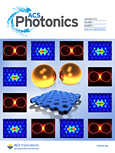
ACS Photonics
Pioneering Breakthroughs in Optics and BeyondACS Photonics, published by the American Chemical Society, is a leading journal dedicated to advancing the interdisciplinary fields of photonics and optics. Since its inception in 2014, the journal has swiftly established itself as a premier platform for the dissemination of groundbreaking research, achieving a distinguished Q1 ranking across several categories including Atomic and Molecular Physics, Biotechnology, Electrical and Electronic Engineering, and Electronic, Optical and Magnetic Materials. With an impressive Scopus Rank and notable percentiles—ranking 19th in Atomic and Molecular Physics and 32nd in Biotechnology—the journal continues to shape the dialogue surrounding innovations in laser technology, optical materials, and biophotonic applications. While the journal does not currently offer open access options, it remains a vital resource for researchers, professionals, and students seeking to explore the cutting-edge developments in this dynamic field. Located in Washington, DC, ACS Photonics is committed to bridging theoretical insights with practical applications, making significant contributions to science and technology.

Advanced Photonics Research
Exploring the Boundaries of Light and TechnologyAdvanced Photonics Research is a leading open-access journal published by WILEY, dedicated to advancing the field of photonics through rigorous research and comprehensive reviews. With its ISSN 2699-9293, the journal aims to disseminate innovative findings in areas such as photonic materials, devices, systems, and applications. Since transitioning to an Open Access model in 2020, it has significantly increased accessibility for researchers, professionals, and students alike, promoting wider dissemination and collaboration within the global photonics community. The journal's commitment to high-quality, peer-reviewed content ensures it remains an essential resource for those seeking to stay at the forefront of photonics research. Positioned to influence both academia and industry, Advanced Photonics Research is an invaluable platform for sharing cutting-edge discoveries that drive the future of technology.

Journal of Biophotonics
Bridging Theory and Application in BiophotonicsJournal of Biophotonics is a prestigious academic journal published by WILEY-V C H VERLAG GMBH in Germany, dedicated to advancing the field of biophotonics through high-quality research. With an ISSN of 1864-063X and an E-ISSN of 1864-0648, this journal is recognized for its contributions within diverse categories, including biochemistry, genetics, molecular biology, chemistry, engineering, materials science, and physics, earning a commendable Q2 ranking in several of these fields as of 2023. The journal aims to bridge the gap between theoretical research and practical applications, fostering interdisciplinary collaboration that is critical for innovations in imaging, diagnostics, and therapeutics. Researchers, professionals, and students alike will find the Journal of Biophotonics invaluable for staying informed about the latest developments and breakthroughs in this dynamic field, making it a cornerstone for knowledge dissemination and scholarly discourse from its inception in 2008 and continuing through 2024.
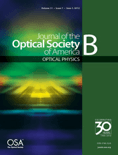
JOURNAL OF THE OPTICAL SOCIETY OF AMERICA B-OPTICAL PHYSICS
Advancing Frontiers in Optical Physics ResearchJOURNAL OF THE OPTICAL SOCIETY OF AMERICA B-OPTICAL PHYSICS, published by Optica Publishing Group, serves as a leading platform for groundbreaking research in the fields of optical physics, atomic and molecular physics, and statistical and nonlinear physics. With an ISSN of 0740-3224 and an E-ISSN of 1520-8540, this esteemed journal has been in circulation since 1984 and is dedicated to advancing the understanding of optical phenomena and related technologies. It holds a commendable position in the academic community, with a 2023 Scopus ranking reflecting its significance—placing it in the top quartile for both Atomic and Molecular Physics and Statistical and Nonlinear Physics. Although it is not an open-access publication, it provides extensive access options to ensure that research is disseminated effectively within the scientific community. This journal is instrumental for researchers, professionals, and students alike, aiming to keep them informed of the latest advancements and trends in optical science. With a convergence of expertise and innovation, JOSA B continues to play a pivotal role in shaping the future of optical research.

OPTICAL AND QUANTUM ELECTRONICS
Exploring the Nexus of Physics and EngineeringOPTICAL AND QUANTUM ELECTRONICS, published by SPRINGER, is a premier journal dedicated to advancing the fields of atomic and molecular physics, optics, and electronic engineering. With an ISSN of 0306-8919 and an E-ISSN of 1572-817X, this journal has established itself as a vital resource for researchers, professionals, and students alike, contributing to the discourse from its inception in 1969 to its continued publications through 2024. It holds impressive rankings in Scopus, placing within the top percentiles for its categories, specifically in the 64th for Electrical and Electronic Engineering and 63rd for Atomic and Molecular Physics. Though it does not currently offer open access options, the journal's robust impact factor reflects its importance within its field, making it an essential reference point for cutting-edge research and developments in materials science and optics. Through its rigorous peer-review process, OPTICAL AND QUANTUM ELECTRONICS remains committed to publishing high-quality, influential studies that push the boundaries of innovation and understanding in these dynamic areas of science.
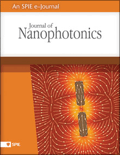
Journal of Nanophotonics
Pioneering Discoveries in NanophotonicsThe Journal of Nanophotonics, published by SPIE-SOC Photo-Optical Instrumentation Engineers, is an esteemed platform dedicated to advancing the field of nanotechnology through pioneering research in photonics. Since its inception in 2007, this journal has become instrumental in disseminating innovative findings and fostering collaborative discussions, especially in the domains of Condensed Matter Physics, Electronic, Optical and Magnetic Materials, and Nanoscience and Nanotechnology. Currently ranked within the Q3 category across these fields, it serves as a vital resource for academics, industry professionals, and students keen on exploring the multifaceted applications and implications of nanophotonic technologies. With its convergence set to continue until 2024, the journal offers a non-open-access model, ensuring rigorous peer-review standards and high-quality publications that contribute to the global body of knowledge.
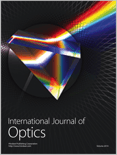
International Journal of Optics
Shaping Tomorrow’s Discoveries in OpticsWelcome to the International Journal of Optics, a distinguished publication dedicated to advancing the field of optics and its interdisciplinary applications. Published by HINDAWI LTD, this open-access journal has been pivotal in fostering knowledge since its inception in 2009. With a robust focus on atomic and molecular physics as well as electronic, optical, and magnetic materials, the journal has carved its niche within Q3 quartile rankings in these categories for 2023, signifying its growing impact and relevance in the scientific community. Researchers and professionals will find a rich repository of innovative and cutting-edge research articles that not only address fundamental aspects of optics but also explore practical applications across various domains. The journal's aim is to promote high-quality research dissemination, enhancing collaboration among scientists and ensuring that pivotal findings reach a global audience. Join us in exploring the dynamic world of optics—where your contributions help shape the future of science.

JOURNAL OF OPTOELECTRONICS AND ADVANCED MATERIALS
Illuminating the Path of Scientific Discovery in OptoelectronicsJOURNAL OF OPTOELECTRONICS AND ADVANCED MATERIALS, published by the NATL INST OPTOELECTRONICS in Romania, is an esteemed academic journal dedicated to disseminating innovative research in the fields of optoelectronics and advanced materials. With an ISSN of 1454-4164 and E-ISSN 1841-7132, the journal provides a platform for researchers to share their findings and technological advancements from 1999 to 2024. Despite being placed in the Q4 quartile across several categories—including Atomic and Molecular Physics, Condensed Matter Physics, and Electrical and Electronic Engineering—the journal serves as an essential resource for highlighting significant developments in its respective fields. Researchers and professionals may find valuable insights that foster collaboration and inspire further investigation, thereby contributing to the continuous evolution of optoelectronics and materials science.
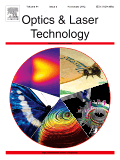
OPTICS AND LASER TECHNOLOGY
Leading the Charge in Optical AdvancementsOPTICS AND LASER TECHNOLOGY, published by Elsevier Science Ltd, is a premier journal dedicated to advancing knowledge in the fields of optics and laser applications. With its impressive Q1 rankings across three critical categories—Atomic and Molecular Physics, and Optics; Electrical and Electronic Engineering; and Electronic, Optical and Magnetic Materials—the journal stands at the forefront of scientific discourse, boasting a significant impact factor that underscores its relevance. Since its inception in 1970, the journal has consistently provided a platform for the dissemination of cutting-edge research, key innovations, and reviews that influence both academic study and practical applications. Although it currently does not have open access options, its rigorous peer-review process and inclusion in esteemed indexing services make it a valuable resource for researchers, professionals, and students seeking to stay informed about the latest developments in optics and laser technology. The journal’s ongoing commitment to quality research ensures it remains a vital publication for those engaged in this dynamic field, with a converged projection extending through 2025.

Plasmonics
Unveiling the Mysteries of Nanoscale InteractionsPlasmonics, published by Springer, is a prestigious journal dedicated to advancing the field of plasmonics and its interdisciplinary applications, with a particular focus on biochemistry, biophysics, biotechnology, and nanoscience. Established in 2006, this peer-reviewed journal serves as a vital platform for researchers to disseminate groundbreaking findings and innovative methodologies related to the manipulation and application of surface plasmons for various technologies. Featuring an impressive Q3 ranking in critical scientific categories, including Biochemistry and Nanotechnology, Plasmonics is recognized for its contribution to enhancing the understanding of nanoscale phenomena and their relevance to contemporary research and development. While currently not an open-access publication, Plasmonics continues to play a key role in bridging academic inquiry and practical application, making it indispensable for professionals and students striving to stay at the forefront of this dynamic field.